Fig. 14

Download original image
Graphs showing computed properties of a calcium MOF utilising the Ca(4p 1P1 − 4s 1S0) transition at 422 nm. The abscissa is detuning – difference between the frequency of the light and the atomic resonant frequency – in units of the Doppler width, Δν D . An applied external magnetic field leads to a splitting of the upper state’s energy level through the Zeeman effect. Graph (a) shows the absorption profiles, α + and α −, for the circular polarisations of the signal light, LHC that drives σ + transitions, and RHC that drives σ − transitions, respectively. The magnetic field strength is 0.04 T, and the temperature T = 720 K. In (b) the corresponding dispersion profiles are plotted for the σ + and σ − transitions for a cell of length 50 mm. The Faraday rotation angle, δ(ν), is plotted in (c) for varying magnetic field strength. Note that optical rotations of the order, or greater than, π are generated for these parameters, as is necessary for efficient atomic filtering. In (d) the transmission profile is calculated for each of the associated Faraday rotation angles in (c). The characteristic two-wing spectral profile is evident.
Current usage metrics show cumulative count of Article Views (full-text article views including HTML views, PDF and ePub downloads, according to the available data) and Abstracts Views on Vision4Press platform.
Data correspond to usage on the plateform after 2015. The current usage metrics is available 48-96 hours after online publication and is updated daily on week days.
Initial download of the metrics may take a while.


